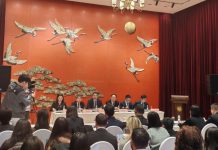
For Yan Liang, Chair Professor of Economics at Willamette University in Salem, Oregon, the United States, the data are daunting. Following recent high-profile meetings on women—the Global Leaders’ Meeting on Women (GLMW) in Beijing in mid-October and the High-Level Conference on the Thirtieth Anniversary of the Fourth World Conference on Women at the United Nations headquarters in New York City on September 23—she observed that, despite decades of efforts, achieving full gender equality “could still take centuries.”
It is a tale of strides in empowerment, but also of persistent, deeply rooted challenges, set against a backdrop of global turbulence and shifting priorities that underscore the universal complexities of this journey.
“When you look at the Sustainable Development Goal score for Goal 5 (Gender Equality), we are only 15.4 percent of the way toward the 2030 targets,” Liang told Beijing Review during an October 15 online discussion on building women’s influence. “This means we’re still very much lagging in achieving gender equality and development. That’s why this kind of conference at this time is very important.”
A moment for global reflection
On October 13-14, Beijing hosted the GLMW, commemorating the 30th anniversary of the landmark 1995 Fourth World Conference on Women, which adopted the Beijing Declaration and Platform for Action. In the decades since, a global surge in women’s empowerment has unfolded, illuminating the path of human progress.
Chinese President Xi Jinping said at the GLMW that over the past three decades, 189 countries have ratified the Convention on the Elimination of All Forms of Discrimination Against Women, with nearly 100 countries enacting some 1,600 laws and regulations to protect women’s rights. Additionally, many nations have adopted action plans to improve women’s wellbeing.
UN Secretary General António Guterres described the Beijing Declaration as “the most ambitious global political commitment on women’s rights ever achieved,” emphasizing its role in advancing legal protection, political participation and education for women worldwide.
Pakistani scholar Zoon Ahmed Khan highlighted the declaration’s milestone status. “Sixty years ago, even in the most developed societies, the idea that women are too emotional to lead was widely accepted. Thirty years ago, the Beijing Declaration recognized women’s rights as a global consensus,” she said during the online discussion.
According to UN Women, the number of women in national parliaments has more than doubled globally over the past 30 years, with the percentage of seats held by women rising from 11.3 percent in 1995 to 27.2 percent in 2025. Moreover, nearly 100 discriminatory laws have been repealed. Girls are now far more likely to be enrolled in and complete their education than at any time in history, Executive Director of UN Women Sima Bahous stated in her remarks at the opening of the 69th Session of the Commission on the Status of Women at the UN headquarters on March 10.
In China, 690 million women had managed to lift themselves out of extreme poverty as of late 2020, the time at which the country achieved the UN’s 2030 Agenda for Sustainable Development poverty reduction target a decade ahead of schedule. Today, women constitute over 40 percent of China’s workforce and more than half of its Internet startup founders.
“We see how China is advancing in terms of STEM (science, technology, engineering and math), business, sports, etc. Women are playing a tremendous role in that. And it all started with Chairman Mao Zedong, who mentioned ‘women hold up half of the sky’—which has created a transformation in China,” Indian national Subhashish Panda, a multinational company employee, said during the online exchange.
Liang’s subsequent comparison to the U.S. provides more context for China’s own gender equality challenges. She pointed out that even a developed nation like the U.S. suffers from regressive trends, including a persistent gender pay gap and restrictions on reproductive rights, despite having more women CEOs. This illustrates a key point: No country has a perfect record. The global struggle for gender equality is complex and uneven, meaning every nation, including China, faces a mix of advances and stubborn setbacks.
A tale of two tiers
While acknowledging global advances, the experts did go on to stress some of the continuing disparities during the discussion. Khan, who has lived in China for years, pointed to a constant gap at the grassroots level. She noted that in many developing countries, women remain economically marginalized. “They see themselves as isolated,” she said.
This “tale of two tiers”—where women’s representation increases in high-level positions but stagnates at the grassroots—is evident globally. Khan shared some observations from her home country: Although women are at times elected to high office, ordinary families still hesitate to send their daughters to work due to safety concerns and social norms.
“The story might be different in bigger cities, but even progressive families often don’t see it as a viable option,” Khan explained. “It’s the patriarchy. It’s the control. It’s the system that’s been in place for long enough to create this perception that somehow it is against religious teachings for women to become more financially independent, to become more autonomous.”
Similarly, in the U.S., Liang mentioned that despite improvements in leadership, with the percentage of women CEOs in Fortune 500 companies rising to 11 percent in 2025 from 7.4 percent in 2020, regressive trends persist at a fundamental level.
“The gender pay gap has [remained largely stagnant and, in some measures,] widened in recent years—the first time since 2003,” she said. The pay gap between full-time, year-round workers, for example, actually increased from 16 percent in 2022 to 17 percent in 2023, a pointed setback.
Another alarming trend, Liang added, is the restriction of abortion access in many U.S. states following the U.S. Supreme Court’s overturning of Roe v. Wade in 2022, which has profoundly undermined women’s reproductive rights and wellbeing.
In India, Panda described a stark dichotomy: Urban women are gradually progressing, but rural women are regressing. He emphasized the need for cross-country learning, suggesting that India could replicate aspects of China’s approach to enhance women’s societal participation.
This approach combines strong legal protections and state-led economic programs to actively integrate women into the workforce and public life as a driver of national development. It includes using quotas for political representation, poverty alleviation projects targeting women and promoting female achievements in education and business.
For a country like India, the transferable lessons might include the strategic use of quotas in local governance, the explicit integration of women’s economic empowerment into national development plans and large-scale digital and financial literacy campaigns targeted specifically at rural women.
Intersections and the way forward
Liang stressed that gender issues intersect with geography, race and income, among others. “‘Gender’ is not a simple concept or a simple construct; it intersects with the many other identities and social positions of women.”
Khan agreed, particularly for developing countries, where resource divides are steepening. “The representation of women in public offices may cover up the urgency to address gender inequality substantively,” she said. “Having women in leadership roles is important, but that does not necessarily translate into equal participation and opportunities on a broader societal level.”
“China is taking the lead through initiatives like global governance frameworks to protect women’s rights, improving laws and institutions, fostering inclusive social development and supporting women’s engagement in governance,” Liang added.
Technology adds another layer of complexity. AI is reshaping the world in a male-dominated industry, often reinforcing discrimination through biased data and algorithms, Guterres warned in his address at the High-Level Conference on the Thirtieth Anniversary of the Fourth World Conference on Women.
“We must confront violence and online hate, and ensure that technology serves equality, not exclusion,” he said, advocating for more investment in women’s education in STEM.
“Women’s participation in decision-making is not a gift; it is a right that strengthens societies and boosts equality,” Guterres emphasized.
To address these gaps, China has already taken concrete steps since the GLWM concluded on October 14, such as establishing the Global Center for Women’s Capacity Building at China Women’s University in Beijing.
Huang Xiaowei, deputy head of the National Working Committee on Children and Women of the State Council, China’s highest state administrative organ, and Vice President of the All-China Women’s Federation, said at the center’s unveiling ceremony that the center demonstrates China’s commitment to “walking the talk.”
Huang expressed hope that the center will foster international exchange, capacity-building cooperation and initiatives to enhance female leadership and digital literacy, in turn contributing to a new paradigm for women’s development and the building of a community with a shared future for humanity.
“These steps and measures need to be taken in a coherent and holistic way, really trying to mobilize our social societal resources,” Liang said. “I think the challenges are just so serious right now and that’s why these kinds of all-out efforts, all our efforts, are very much needed.” –The Daily Mail-Beijing Review news exchange item





